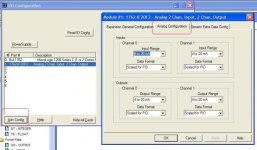Hello,
I've used PLCs in the past to perform very basic ladder logic, but I've never used one for a 4-20 mA output to drive a pump before. My pump takes a 4-20 mA signal to adjust the flow rate, but I need the Allen Bradley Micrologix 1200 (model L40BWA series C) with the analog module 1762-IF20F2 to creat the 4-20 mA output to the pump.
I'm having a little difficulty figuring out how to get the 4-20mA output. I have 24Vdc powering my PLC, and wires connected from out 8 and out 9 to the analog module at terminals IN 0 (+) and IN 0 (-). I'm not sure yet but I think this wiring is correct... although the outputs of the PLC might not matter (the 1762-IF20F2 instruction file says the 4-20mA corresponds to bits 8 and 9, but I don't recall if there's any correlation between the bits and the actual terminals).
I believe the thing I'm missing here is the actual code necessary to give 4-20 mA control. I'm aware of the PID function, but I've never used it before. I'm not sure I should use it here because under Module Adv Config for a Data Format I've selected "Raw/Proportional" rather than "Scaled for PID."
If someone could show me the code or instructions necessary to create a 4-20 mA output it would be very much appreciate. I believe I need to vary a 0-10V output from the PLC to the analog expansion module so the module can in turn output a proportional 4-20 mA signal to the pump. Please correct me if I'm wrong and if possible, explain how I can achieve this goal.
Thank you in advance for your assistance.
I've used PLCs in the past to perform very basic ladder logic, but I've never used one for a 4-20 mA output to drive a pump before. My pump takes a 4-20 mA signal to adjust the flow rate, but I need the Allen Bradley Micrologix 1200 (model L40BWA series C) with the analog module 1762-IF20F2 to creat the 4-20 mA output to the pump.
I'm having a little difficulty figuring out how to get the 4-20mA output. I have 24Vdc powering my PLC, and wires connected from out 8 and out 9 to the analog module at terminals IN 0 (+) and IN 0 (-). I'm not sure yet but I think this wiring is correct... although the outputs of the PLC might not matter (the 1762-IF20F2 instruction file says the 4-20mA corresponds to bits 8 and 9, but I don't recall if there's any correlation between the bits and the actual terminals).
I believe the thing I'm missing here is the actual code necessary to give 4-20 mA control. I'm aware of the PID function, but I've never used it before. I'm not sure I should use it here because under Module Adv Config for a Data Format I've selected "Raw/Proportional" rather than "Scaled for PID."
If someone could show me the code or instructions necessary to create a 4-20 mA output it would be very much appreciate. I believe I need to vary a 0-10V output from the PLC to the analog expansion module so the module can in turn output a proportional 4-20 mA signal to the pump. Please correct me if I'm wrong and if possible, explain how I can achieve this goal.
Thank you in advance for your assistance.



